What Issues do SCIFs Face in Relation to ADA Compliance?
The Government Accountability Office (GAO) recently released a report that found that the federal agencies using SCIFs and SAPFs have failed to consistently address accessibility for disabled people in their facilities. SCIFs fall under requirements from the Office of the Director of National Intelligence (ODNI), and GAO found that “ODNI has not issued guidance identifying minimum specifications for common accessibility concerns and addressing accessibility in inspections,” the report said.

What Challenges are SCIFs Facing with Accessibility?
Some of the challenges with accessibility in SCIFs are harder to address because they’re a symptom of the necessary security mitigations. For example, entrance doors to SCIF that meet ICD 705 requirements for acoustic and RF mitigations require more than the five pounds of force maximum set under the Americans with Disabilities Act (ADA). The ADA is also moving faster than government standards when it comes to creating requirements for meeting needs for accessibility.
The difficulty of addressing any accessibility issues varies greatly between different facilities. The GAO report found some were not construction issues but rather issues in how the facility was being used, where tables, chairs and boxes obstructed access in a way that would impact wheelchair users. In other facilities, there was a lack of braille signage. Both these issues would be quick fixes. However, other problems like a vestibule being too small or door hardware being too high are issues that began with construction and can be a large project to address.
In the case of something like a vestibule that is not accessible to wheelchair users or others with mobility aids, that would require a complete renovation of the space to correct, and since this is the front of the facility, that means that access to the facility will be impacted and it could impact the program’s ability to operate within the space. Because of the way SCIF entrance doors are constructed, hardware cannot be easily moved. Lowering door hardware would likely mean buying an entirely new door.
While we don’t know for sure how ODNI will respond to GAO’s report, it’s likely that changes in standards will come in the future with the aim of increasing accessibility. Because of that and the difficulty of renovating a secure space for accessibility, it’s best to be thinking about those future requirements now.
How Will SCIFs Address Accessibility in the Future?
Version 1.6 of the ICD 705 Tech Spec may come with new requirements for accessibility when it is released, but it’s best not to wait until it’s a requirement to begin building SCIFs with accessibility and ADA standards in mind. Renovations can be incredibly costly, so the best way to handle this is to try to meet requirements before they’re required and avoid having to make a change later.
While new facilities can build with ADA in mind to try to preemptively meet future ODNI requirements, existing facilities will likely need to undergo changes. Some of this may be a simple fix, like rearranging furniture or adding braille signage, but some renovations will be complicated and expensive.
While disability accessibility is a major concern for SCIFs, it may not be the only one that will need to be considered as the way SCIFs are constructed changes. In the future, ODNI may need to address the mental toll that working in a facility like a SCIF can take. As warfare becomes increasingly remote with reliance on technology like drones, people are spending more of their careers in these facilities. Spending long hours in a six-sided box with no windows or natural light and constant white noise can negatively impact people to a significant degree, especially when that is a more permanent assignment.
With any SCIF construction, security is always at the forefront, but it isn’t the only factor to consider. If you’re concerned about your facility’s current accessibility, or need someone to help you construct a new facility with future requirements in mind, Adamo can help. Our team of consultants can help guide you through the construction process and make it easy. If you’re looking for a team to build your facility with current and potential requirements in mind, you can trust our design and construction team and their 100% accreditation rate to get the job done right the first time. Contact us today to learn how Adamo can help you meet your mission needs without any headaches.




